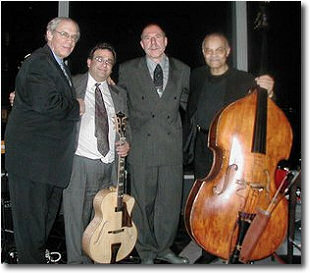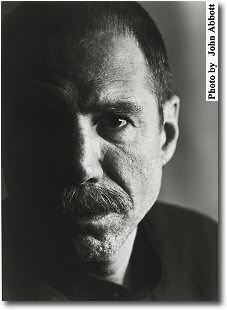|

Todd Barkan, Tony
Lombardozzi, Giacomo Gates, Earl May
Photo courtesy of Roberta Zlokower
Giacomo Gates
Vocals
Earl May Bass
Tony Lombardozzi Guitar
Scat has never sounded so good. With Earl May on mellow bass and
Tony Lombardozzi on creative guitar,
Giacomo Gates lit up
Dizzy's Club Coca-Cola tonight with pizzazz. Giacomo peppers his songs with personal anecdotes and charming jokes that draw his audience into this warm, candlelit ambiance. An early song, about never saying the word, "love", was bluesy and full of Earl's endless and mature bass. Lady Be Good, brought deep vocals and twisted lyrics, with a breathless story in one beat! This imaginative improvisation is rare and worth the visit on its own.
Jeanine, a fast-paced swing, featured Tony's rapid guitar fingering and generous heaps of scat. Blue Skies and In Walked Monk were bound together effortlessly and with engaging lyrical arrangements. In fact, inspired lyricism is a quality found in all of Giacomo's songs, with additional asides and retro jazz references.
Dizzy Gillespie and Max Roach figured in one anecdote, prior to Giacomo's singing, as if he's a human bass. I Cover the Waterfront and I Just Got Back in Town were sung with romantic reference and steady guitar embellishments, with an endearing refrain about Paris.
Let's Cool One, from the 1940's, preceded Stolen Moments, and Giacomo created a magical fantasy of mind expansion. It's Over Now, with slow, melancholy instrumental solos, found Giacomo now a human drum, then vocalist, one more time.
Dizzy's Club Coca-Cola upcoming events are listed on
Dizzy's Club Coca-Cola Website.
Dizzy's Club Coca-Cola
Time/Warner Center
Broadway at 60th Street
NY, NY
212.258.9595
Todd Barkan, Host
|
 The criteria for defining jazz singing will probably be argued for the rest of time. But no matter which side of the argument one may be on, there can be no doubt that Giacomo Gates is an authentic jazz vocalist. Heavily steeped in the traditions of the original vocal improvisers from Louis Armstrong and Ella Fitzgerald through their modern counterparts Betty Carter and Leon Thomas, Giacomo's own approach draws most heavily from the bebop-rooted masters like Jon Hendricks, Babs Gonzales, King Pleasure and most of all, Eddie Jefferson. Like his influences, Gates has forged his own unique path. The criteria for defining jazz singing will probably be argued for the rest of time. But no matter which side of the argument one may be on, there can be no doubt that Giacomo Gates is an authentic jazz vocalist. Heavily steeped in the traditions of the original vocal improvisers from Louis Armstrong and Ella Fitzgerald through their modern counterparts Betty Carter and Leon Thomas, Giacomo's own approach draws most heavily from the bebop-rooted masters like Jon Hendricks, Babs Gonzales, King Pleasure and most of all, Eddie Jefferson. Like his influences, Gates has forged his own unique path.
In his own words, "In this kind of music it's about intention, honesty and what comes through in your voice - the Experience of Life." Without question, Giacomo's life experience is unlike any other jazz artist that may come to mind. Blessed with a full-bodied and mellifluous voice, extraordinary rhythmic precision and an unerring sense of lyricism, Gates' total command of the vernacular, boundless creativity and exuberant passion set him apart from nearly every other vocalist on the scene. However, he didn't display his talents to the public-at-large until 1990, at 40 years of age. Prior to that, Gates led the life of a hardworking blue collar ‘man's man.' After a number of years driving everything from school buses to cattle transporters to 18-wheelers, Giacomo departed for the Alaskan wilderness in 1975, working for 14 years in a variety of jobs, including three years on the Alaska Pipeline. Whether he was doing road construction, operating scrapers, loaders and bulldozers, or driving spikes into railway tracks in the flatland emptiness of the tundra with no directional guides other than a compass and the sky, Gates found these experiences to be powerful stimulation for developing his own artistic expression.
"Two things always struck me out there," Giacomo says of that experience, "feeling insignificant and feeling very alive." With severe risk to life and limb from all sorts of dangers ranging from geographic disorientation to heavy machinery accidents to hungry polar bears, Gates was confronted with sights, sounds and experiences that had a profound effect upon his being, and therefore his art.
Although he had always been exposed to music since early childhood, singing and playing guitar through his teenage years, there were no real opportunities to perform in Alaska until nearly the end of his time there. Looking for growth and development even as a construction worker, Gates would occasionally leave Alaska to spend time in places like Washington State and Tucson, Arizona working on new projects and learning the use of new equipment. In those more civilized environments, he would perform whenever possible, sitting in on a variety of musical activities. In the late ‘80s, he had many opportunities to do the same in Fairbanks, Alaska, where he occasionally moonlighted as a bouncer in local clubs. After much encouragement from local and visiting performers, Giacomo decided to return to his native Connecticut and devote full attention to his music.
Like his mentors, Gates would sometimes translate great instrumental solos into Vocalese, including the works of Lee Morgan, Chet Baker, Gene Ammons, Charlie Rouse and many others, also penning lyrics to classic jazz compositions. In citing his influences, Giacomo states "Some of my favorite singers are Dexter Gordon, Ben Webster and Lester Young. They were singing through the horn. If that isn't singing, I don't know what is!"
From that perspective, Giacomo sometimes vocalizes as an instrument – trombone, flute, bass and even drums. There's no contrivance or gimmickry for its own sake involved in this, as it's entirely conceived within the context of the music. Originally developed while working a steady duo gig with a pianist in Connecticut, Giacomo would improvise bass lines or drum sounds in support of the piano solos. Invited onstage by Jon Hendricks during a performance in 1995, Gates sang drums to Hendricks' bass accompaniment of the pianist. After that, the instrument vocal became a regular part of his program. Although he and Jon Hendricks have performed together two other times, their talk of doing something on a more regular basis hasn't occurred. However, in June of 2004 Giacomo and Andy Bey subbed for Jon and Kevin Mahogany in Europe, performing with the other two regular members of The Four Brothers vocal ensemble, Mark Murphy and Kurt Elling. Giacomo has also performed with such notables as Lou Donaldson, Freddie Hubbard, Richie Cole, Randy Brecker, Jon Faddis and Hilton Ruiz. But his primary focus has been leading his own groups, which has taken him all over the U.S. and other parts of the world.
Playing major U.S. clubs, New York's Birdland, the Five Spot and the Jazz Standard, Philadelphia's Zanzibar Blue, Blues Alley in D.C. and Snug Harbor in New Orleans; and major festivals like Detroit/Montreux, Telluride, Caramoor, Sedona, Clearwater, Fairbanks Summer Arts, etc.; and at countless universities and jazz societies, Giacomo's enormous appeal and popularity are obvious from the many repeat engagements he has had at these venues. He's also performed and taught in Europe and has toured Australia twice.
Gates has three heavily acclaimed CDs, with his most recent release, Centerpiece on Origin Records garnering rave reviews and receiving heavy airplay on over 300 stations, with over three months in the top 20 of the Jazz Week charts.
Heavily committed to education, Giacomo teachers regularly at Wesleyan University, the Hartford Conservatory of Music and New Haven's Neighborhood Music School and has conducted workshops and residencies at numerous educational institutions all over the U.S.
Like all seriously committed jazz artists, Giacomo Gates is a student of the music's great legacy. Known for his interaction with his live audience through witty patter and informative introductions, every performance becomes a lesson in jazz history. With over 100 live performances in 2004 and a 2005 schedule that will surpass that, Giacomo's sheer joy, exuberance, wit and unlimited creativity make him one of jazz' most compelling artists.
|
Insert a comment
|
© 2000 - 2025 All the material published on Jazzitalia is exclusively owned by the author. Moreover it is protected by International Copyright, so it is forbidden any use of it which isn't authorised by the rights' owner.
|
This page has 6.661 hits
Publishing Date: 11/06/2005

|
|

